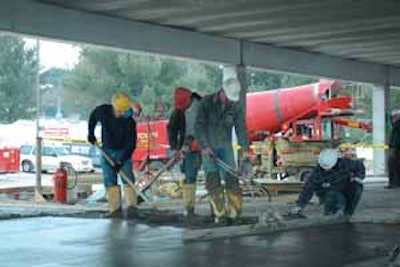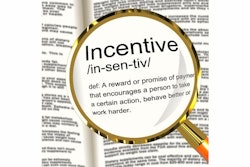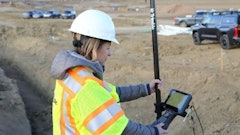
The last thing smart contractors want to do is to let good workers get away.
There are an ample number of methods that should always be employed to keep good workers working, from verbal recognition to gifts for a job well done. However, though such actions and communications are important, these will not always be enough to keep the best employees. A final strategy you may need to consider is incentive pay.
Incentive pay can come in many forms. Most commonly, there is the traditional cash bonus at the end of the year. For many top performers this is a nice way to end the year. For example, a worker who made $50,000 in wages for the year is given a $5,000 bonus (10 percent of his wages).
The cash bonus is a great form of incentive pay but is subjective. Most contractors simply pull a dollar figure out of the air, depending on the amount of profit made for the year.
While there is nothing necessarily wrong with this, it doesn't really offer any form of incentive that might inspire greater performance, quality workmanship and long-term loyalty. Here are three incentive plans that are simple to construct, easy to administer, and will reinforce your objective of gaining greater performance and loyalty from good performers.
Gain sharing
Gain sharing has gained an increasing acceptance among contractors. Previously, gain sharing was most associated with companies in the manufacturing industries. Gain sharing is the money given (shared) to workers when they have surpassed some previously established productivity level. The positive difference between what was the predetermined level of profitability, say 5 percent, and what was achieved, say 7 percent, is recognized as a gain, in this case 2 percent. A portion of this gain would be paid out to the workers involved in the form of a bonus.
Consider a concrete flatwork company. The owner sets a target of 25 percent gross profit. This represents the percentage made after direct costs of construction have been subtracted from the gross revenue amount. Gross profit, or gross margin, is the proper number to use since employees can impact at least two of the items that are most associated with direct costs: equipment use and labor. To a great degree they also impact proper use of materials.
A gain sharing percentage now needs to be determined. This percentage should be established prior to commencing a project or season so workers cannot claim that the owner is changing the percentages to work in the owner's favor. Let's work on a gain sharing percentage of 40 percent. At the beginning of the year, the owner stated that he wanted to shoot for a 25 percent Gross Profit (Target).
Example:
Job Size ($) $20,000
Direct Costs $14,000
Gross Margin $ 6,000
(Gross Profit (%) 30% GP)
Gain Made: 30 - 25% (Target) = 5%
Gain Realized: 5% x $20,000 = $1,000
Now, the total gain sharing amount made on this particular job was $1,000. The owner had preset the gain sharing amount to be 40 percent. Therefore, the money due in a payout to the workers is $400 ($1,000 x 40 percent).
While this single amount doesn't look to be much, if this same contractor completed 150 jobs during the season, all averaging just $400 in gain sharing made, then the total bonus fund would be $60,000. If the contractor had 20 employees and the individual payout was to be divided equally among the employees, the individual payout would be $3,000 per employee.
What is the "WIIFM" (What's in it for me?) for both the owner and the employee? This is simple. First, the employee is rewarded for performing work with little to no waste, good communication, planning, etc. The more employees take care to perform their work the right way to begin with, the better their dollar payout will be per hour worked. The incentive for the worker is that they do not have to work hours and hours of overtime to make more money. By performing things right the first time on the job, they will make more money if gains are made.
The owner is rewarded because he actually creates a built-in incentive for the worker without trying to budget additional dollars for a bonus or to figure out what amount should be paid. This reduces the stress on the owner, thus allowing the incentive to be tied directly to production.
The manner of payout for the gain sharing can also be creatively accomplished. My suggestion would be to track each job on a monthly basis. At the conclusion of each month, take the jobs that experienced a gain, pay out 50 percent of the amount previously determined in a monthly bonus or gain sharing check, and place the other half into an escrow account that will be paid out at year's end. In this method the employee is experiencing a little incentive on a monthly basis, and a much larger financial benefit at the end of the year.
Pay for knowledge
Pay for knowledge is another incentive that works to inspire greater skill development and tenure from the employees of your company. One trait that often sets the best employees apart from others is their desire to learn more about their job and industry and to become more proficient at one or more tasks. Contractors can turn this drive to excel into a great incentive for the worker.
Pay for knowledge begins first when a contractor defines what skills are needed for each job function. The items listed for a specific job function should be prioritized so that there is a progression of skills and knowledge that will be learned along the way to an employee becoming proficient.
As an employee begins to learn the skills and acquires the needed knowledge for a job function, they receive increases in pay. For example, consider a new laborer who wishes to become a decorative finisher. The worker's beginning hourly wage might be $10.50 per hour. As the worker gains knowledge about basic tools and equipment, he might receive an increase of $0.25 to $0.50 per hour. As the employee continues to learn and develop his skills, his hourly wage would continue to reflect an appropriate increase for his acquired knowledge.
Contractors should be careful to control the amount of skills and knowledge that can be learned in a period of time. Some workers, wanting to make more money in a short amount of time, might spend all their time learning new skills while not becoming very proficient in the skills. It is important that the skills and knowledge acquired are relative to the work the employee completes.
Pay for knowledge is good for those committed workers who are truly gifted and have the desire to cross-train on additional skills, thus expanding their horizons. Also, these same workers greatly appreciate the reward for their additional hard work and learning. They also tend to be more loyal to the contractor who proves his appreciation by putting his money where his mouth is.
Tenure bonus
It is smart business to recognize those workers who stay with your organization. It not only rewards those loyal employees directly, but it also sends a message to other employees that you recognize experienced workers and appreciate their years of service. The amount of bonus should be on an escalating scale.
Remember, the dollar amount is not necessarily as important as the commitment to provide such an incentive. The tenure bonus is extremely important to maintain the older and often more experienced worker. Its placement in your business sends the message that you value experience and value those who remain with your company through the years.
Instituting one or more of these incentive plans can help to increase employee morale, performance, and satisfaction. Satisfied workers normally work harder, cause less conflict and contribute more to the overall work results. Implementing an incentive pay system will position your business as the construction company of choice, setting your company apart from the other contractors who demonstrate little to no appreciation for the hard work their people contribute.
Brad Humphrey is president and founder of Pinnacle Development Group, Inc., a consulting and training organization dedicated to the construction industry. He is also a frequent speaker at World of Concrete and other industry events. For more information, e-mail Brad at [email protected].



















